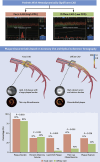Impactful Cardiac CT and MRI Articles from 2023
- PMID: 39446045
- PMCID: PMC11540293
- DOI: 10.1148/ryct.240142
Impactful Cardiac CT and MRI Articles from 2023
Abstract
Cardiac imaging is important in diagnosing, treating, and predicting prognosis in patients with cardiovascular disease. Imaging protocols and analysis are consistently evolving, and the implementation of artificial intelligence-based applications is of increasing interest. This review presents recent advancements in noninvasive cardiac imaging, specifically focusing on cardiac CT and MRI, from notable publications across multidisciplinary journals in 2023 of interest to both radiologists and referring clinicians in the field. The discussion encompasses the latest trials of CT fractional flow reserve and the performance of the newest generation of photon-counting detector CT, particularly in coronary stenosis quantification. Additionally, it addresses coronary plaque quantification using artificial intelligence applications and their implications from large patient cohorts, alongside prognostic outcomes, and the value of coronary artery calcification scores. Various aspects of CT trials, such as anatomic planning before revascularization, high-risk plaque features, outcomes, and pericoronary fat index, are evaluated. New insights from cardiac MRI trials for cardiomyopathies, including cardiac amyloidosis, dilated cardiomyopathy, hypertrophic cardiomyopathy, myocarditis, and valvular disease, are also outlined. The review concludes by highlighting impactful societal statements and guidelines. Keywords: CT Angiography, MR Imaging, Transcatheter Aortic Valve Implantation/Replacement (TAVI/TAVR), Cardiac, Coronary Arteries, Heart, Left Ventricle © RSNA, 2024.
Keywords: CT Angiography; Cardiac; Coronary Arteries; Heart; Left Ventricle; MR Imaging; Transcatheter Aortic Valve Implantation/Replacement (TAVI/TAVR).
Conflict of interest statement
Figures

![The Prospective Randomized Trial of the Optimal Evaluation of Cardiac
Symptoms and Revascularization (PRECISE) study evaluated the clinical
utility of CT in the stable chest pain setting evaluating whether a combined
CT and CT-FFR strategy would impact catheterization laboratory efficiency
and incident major adverse clinical events (MACE) compared with the usual
testing pathways. Each phase of the PRECISE trial is outlined in A, a key
point being that the low pretest probability group (20.2%) underwent
deferred testing. Kaplan-Meier curves at a median of 11.8 months show (B)
the primary composite end point (death from any cause, nonfatal myocardial
infarction [MI], invasive catheterization without obstructive coronary
artery disease [CAD]) and (C) death or nonfatal MI. The insets show the same
data on an enlarged y-axis. The most important results were that
catheterization without obstructive CAD was improved using CT-FFR and there
was no statistically significant impact on safety (death, nonfatal MI) at 1
year. CT-FFR = CT fractional flow reserve, PMRS = Prospective Multicenter
Imaging Study for Evaluation of Chest Pain minimal risk score. (Adapted,
with permission under a CC BY-NC-ND 4.0 license, from reference
3.)](https://cdn.ncbi.nlm.nih.gov/pmc/blobs/6c40/11540293/61b77a7bfeee/ryct.240142.fig2.gif)






![Kidoh et al explored the diagnostic performances of the traditional
MRI ECV method and the newer method of myocardium to lumen R1 ratio on
postcontrast T1 maps, which has the advantage of not requiring a native T1
map and hematocrit levels. (A) Example of region of interest placement on
postcontrast T1 maps in a patient with cardiac amyloidosis. The ratio of
myocardial R1 to luminal R1 on the postcontrast T1 map was defined as
postcontrast myocardium to lumen R1 ratio. (B) Postcontrast T1 map in a
70-year-old male individual with suspected cardiac amyloidosis. The mean R1
values of the septal wall were higher than those of the lumen (postcontrast
myocardium to lumen R1 ratio = 1.36). The ECV value was 78% (abnormally
high). Wild-type transthyretin amyloidosis (ATTRwt) was confirmed using
genetic testing. (C) Receiver operating characteristic curves for the
detection of patients with cardiac amyloidosis. The highest area under the
receiver operating characteristic curve (AUC) was attained with ECV (0.99
[95% CI: 0.97, 1.00], P < .001), followed by Λ (0.98 [95% CI:
0.96, 0.99], P < .001), and then, postcontrast myocardium-to-lumen R1
ratio (0.98 [95% CI: 0.95, 0.99], P < .001). There was no evidence of
a difference in AUC between ECV and postcontrast myocardium to lumen R1
ratio (P = .10) or between Λ and postcontrast myocardium to lumen R1
ratio (P = .19). ECV = extracellular volume fraction. (Adapted, with
permission, from reference 21.)](https://cdn.ncbi.nlm.nih.gov/pmc/blobs/6c40/11540293/8ca9707b1456/ryct.240142.fig9.gif)
![Heydari et al sought to evaluate sex-specific prognostic performance
in a multicenter Stress CMR Perfusion Imaging in the United States [SPINS]
Study registry of 2349 patients. The primary outcome measure was a composite
of cardiovascular death and nonfatal myocardial infarction. At the 5.4-year
median follow-up, female individuals with normal stress cardiac MRI findings
had a low annualized rate of primary composite outcome similar to male
individuals (P value was nonsignificant). In contrast, female individuals
with abnormal cardiac MRI findings were at higher risk for the primary
outcome compared with female individuals with normal cardiac MRI findings.
Presence of abnormal stress cardiac MRI findings was an independent
predictor for the primary outcome measure. There was no effect modification
for sex. Female individuals had lower rates of invasive coronary angiography
and downstream costs at 90 days following cardiac MRI. There was no effect
of sex on diagnostic image quality. (Reprinted, with permission, from
reference 22.)](https://cdn.ncbi.nlm.nih.gov/pmc/blobs/6c40/11540293/a46786b3eb2a/ryct.240142.fig10.gif)




References
-
- Simon J , Hrenkó Á , Kerkovits NM , et al. . Photon-counting detector CT reduces the rate of referrals to invasive coronary angiography as compared to CT with whole heart coverage energy-integrating detector . J Cardiovasc Comput Tomogr 2024. ; 18 ( 1 ): 69 – 74 . - PubMed
-
- SCOT-HEART Investigators ; Newby DE , Adamson PD , et al. . Coronary CT angiography and 5-year risk of myocardial infarction . N Engl J Med 2018. ; 379 ( 10 ): 924 – 933 . - PubMed
Publication types
MeSH terms
LinkOut - more resources
Full Text Sources
Medical

